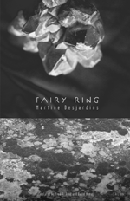
Fairy Ring
Martine Desjardins
Translated by David Homel
Talonbooks
$18.95
trade paper
224pp
0-88922-449-8
Clara Weiss, wife of malodorous mycologist Edmond, must undergo a sleep cure following her discharge from the sinister Clavel Clinic in New Raven. Leaving behind the incestuous self-absorption of New Raven high society, the recently married couple rent Captain Ian Ryder’s house on a remote stretch of the Nova Scotia coast. In the months which follow, two campaigns play themselves out simultaneously: Captain Ryder’s mission to penetrate the North Pole aboard his ship the Nivalis, and Edmond Weiss’s mission, aided and abetted by the medical establishment, to penetrate his wife. Meanwhile, as a foil to Clara’s distress, the escapades of the New Raven social circle demonstrate the arbitrary definition of insanity.
As might be expected of a novel set in 1895, death and disfigurement provide some comic relief amidst the tortured sexuality. However, the genius of this very black humour lies in a resolutely satirical appropriation of that peculiar Victorian voice which equally describes a velvet antimacassar or a surgical procedure in earnest and formal adjective-bedizened terms. (Unfortunately, like obnoxious cellular telephones interrupting a period film, American spellings in the galleys break the otherwise beautifully sustained semblance of Victorian-era Atlantic Canada.) The very artifice of this language works to reveal how barbaric procedures and attitudes can come to be accepted and reproduced in a given society. For instance, Joachim Moss describes his operation thus:
The constricting embrace of the bindings prevented my head from being pulled back and forth by the saws. The time had come to install the tripod atop my skull.
I heard the sinister grating of the screw as it entered the bone, then a cracking.
I felt my head being pulled as one might extract a tooth. Was my skull about to split into a million fragments? Panic-stricken, I opened my eyes. The varnished hardwood floor was awash with blood.
A prodigious vocabulary tinged with Latin suggests that Fairy Ring was written either by a polymath or by someone fond of encyclopedias. Whether describing the mating behaviour of dragonflies or casting polite dialogues on the Gnostic Gospels’ points of contention, Desjardins is as much an erudite essayist as she is an engaging fabulist. One may conclude that such lucubrations issued upon prolonged and entranced perusal of newspaper cuttings, T. Eaton & Co. Purchaser’s Guides, novels, botanical monographs, and medical textbooks of the era. The effect is like watching a wax doll quivering to life.
In this uncanny return of the surreal, this literary equivalent of a Max Ernst collage assembled from Victorian woodcuts, the dream sequence is supercharged with associations. Paradoxically, though, the intrusion of Clara’s dreams into this chimerical, morphine-addled world breaks the reverie of the novel as a whole. While the recording of dreams is the easiest way to limn a sleep-cure patient (victim), here the device appears arch and redundant.
Nonetheless, Fairy Ring is a feat. Demonstrating an agile imagination, pyrotechnic vocabulary and a literary style decanted by the drop, Desjardins approaches the aesthetic quintessence. mRb






0 Comments